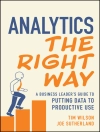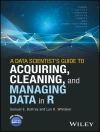This volume presents a selection of research papers on various topics at the interface of statistics and computer science. Emphasis is put on the practical applications of statistical methods in various disciplines, using machine learning and other computational methods. The book covers fields of research including the design of experiments, computational statistics, music data analysis, statistical process control, biometrics, industrial engineering, and econometrics. Gathering innovative, high-quality and scientifically relevant contributions, the volume was published in honor of Claus Weihs, Professor of Computational Statistics at TU Dortmund University, on the occasion of his 66th birthday.
قائمة المحتويات
Part I Methodological Developments in Data Science.-Aviation Data Analysis by Linear Programming in Airline Network Revenue Management.- Bayesian Reduced Rank Regression for Classification.- Modelling and classification of GC/IMS breath gas measurements for lozenges of different flavours.- The Cosine Depth Distribution Classifier for Directional Data.- A Nonconformity Ratio Based Desirability Function for Capability Assessment.- Part II Computational Statistics.- Heteroscedastic Discriminant Analysis using R.- Comprehensive Feature-Based Landscape Analysis of Continuous and Constrained Optimization Problems Using the R-Package flacco.- Part III Perspectives on Statistics and Data Science.- A Note on Artificial Intelligence and Statistics.- Statistical Computing and Data Science in Introductory Statistics.- Approaching Ethical Guidelines for Data Scientists.- Part IV Statistics in Econometric Applications.- Dating Lower Turning Points of Business Cycles – a Multivariate Linear Discriminant Analysis for Germany 1984 to 2009.- Partial Orderings of Default Predictions.- Improving GMM efficiency in dynamic models for panel data with mean stationarity.- Part V Statistics in Industrial Applications.- Economically designed Bayesian np control charts using dual sample sizes for long-run processes.- Statistical analysis of the lifetime of diamond impregnated tools for core drilling of concrete.- Detection of anomalous sequences in crack data of a bridge monitoring.- Optimal Semi-Split-Plot Designs with R.- Continuous process monitoring through ensemble based anomaly detection.- Part VI Statistics in Music Applications.- Evaluation of Audio Feature Groups for the Prediction of Arousal and Valence in Music.- The Psychological Foundations of Classification.
عن المؤلف
Nadja Bauer is a Lecturer at Dortmund University of Applied Sciences and Arts, Germany. Her research interests include industrial statistics, music data analysis and statistical education.
Katja Ickstadt is a Professor of Mathematical Statistics with Applications in Biometrics at the Faculty of Statistics, TU Dortmund University, Germany. Her main research areas include regression modeling and methods for biomedical applications, in particular from a Bayesian viewpoint.
Karsten Lübke is a Lecturer for Statistics and Mathematics at FOM University of Applied Science, Essen, Germany. His main research interests are in statistical education and data literacy.
Gero Szepannek is a Professor of Statistics and Business Mathematics at Stralsund University of Applied Sciences, Germany. Prior to this he worked for seven years at Santander as head of scoring and rating models. His main research interests are in machine learning, computational statistics, NLP, credit risk modeling and music information retrieval.
Heike Trautmann is a Professor of Information Systems and Statistics at the University of Münster, Germany and Director of the European Research Center for Information Systems (ERCIS). Her research chiefly focuses on data science, optimization, and automated algorithm selection.
Maurizio Vichi is a Full Professor of Statistics and Chair of the Department of Statistical Sciences at Sapienza University of Rome, Italy. He also serves as Coordinating Editor of the international journal Advances in Data Analysis and Classification, published by Springer. His research interests include statistical models for clustering, classification, dimensionality reduction, and new methods for official statistics.












